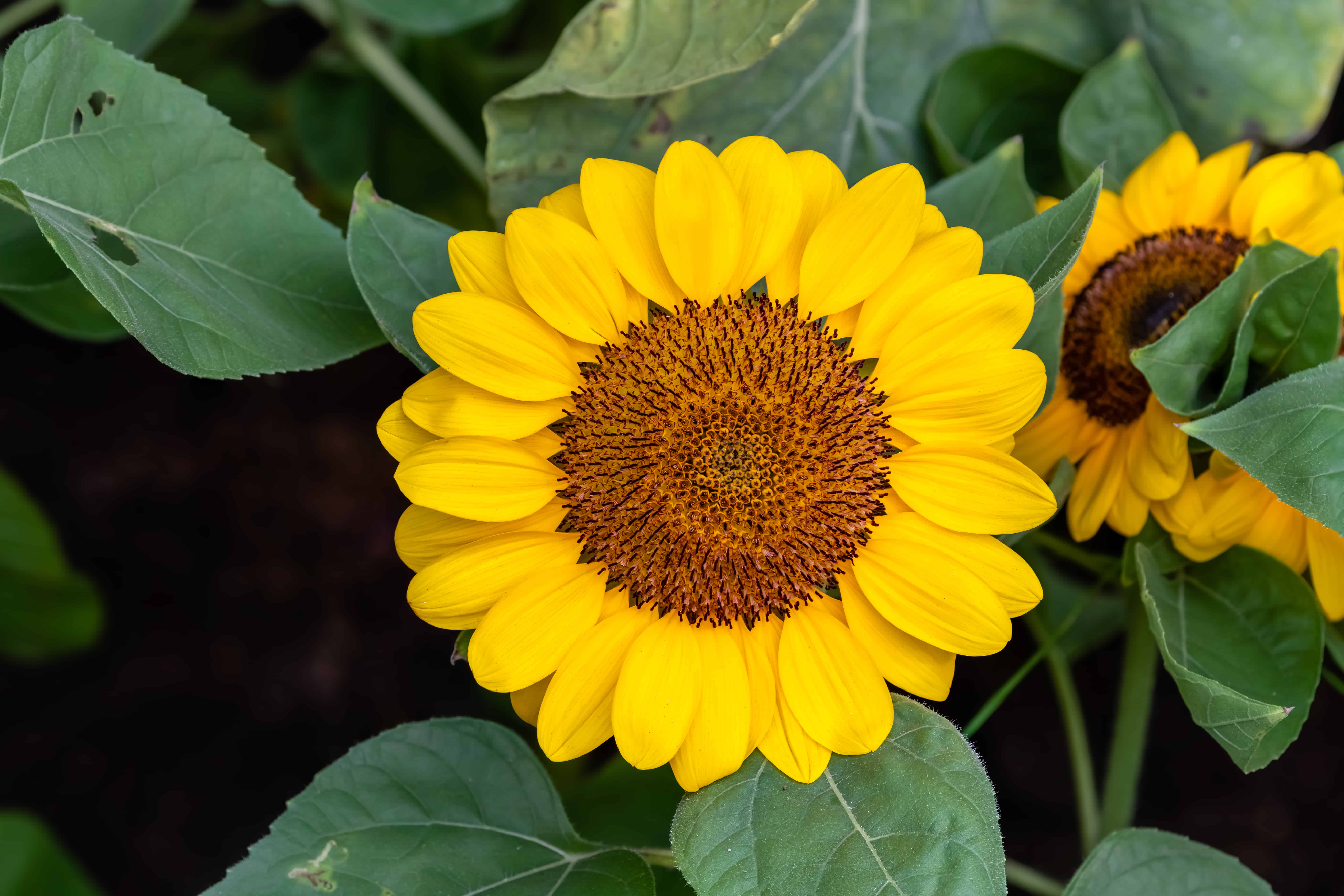For many gardeners, choosing flowers to plant in May is an annual tradition. And by annual, we mean annual flowers: plants that grow during a single season, then die off when summer ends. While planting annual flowers means having to buy new plants every year, choosing them for your garden beds has some advantages. For one thing, annual flowers grow quickly, and they generally aren’t hard to grow. So they’re great for bringing the bare patches in your landscape back to life. And annuals are a versatile group of plants. You can find annual flowers that will grow in shade, in sun, in containers, in baskets and window boxes, in that weird spot back by the fence where nothing grows … pretty much anywhere you want.
Best of all, annuals offer a wide range of options for adding flowers to your garden. They come in an endless assortment of colors, sizes, and shapes. Many will bloom all through the summer. And hey, if it doesn’t work out, you can try something different next year. Of course, annual flowers do need some care. Some of them need to be deadheaded (meaning dead flower buds need to be removed to encourage more growth). And you need to make sure they get the water they need (some of them are more harmed by overwatering than going dry). But the effort is worth the reward. Whether you’re a first-time gardener or a seasoned pro, planting annual flowers will surely set you up for a colorful summer.
When and How Do I Plant Annuals?

With so many options, it’s not always easy to decide which annual flowers to plant.
©Krakenimages.com/Shutterstock.com
A key rule for planting annual flowers is to wait until the last frost date has passed. That’s the date in spring when the danger of nighttime temperatures dropping below freezing has passed. For much of the country, the last frost date falls in April or May. But you’ll want to check for the last frost date in your area and plan accordingly.
An easy way to plant annuals is to buy small starter plants from a nursery or garden center, and plant them into a garden bed or container. Some annuals are particularly easy to grow from seeds, either sown directly into your garden, or started indoors and transplanted after the frost day. It may seem like annuals offer almost too many possibilities to choose from. But don’t throw in the trowel. Just peruse our choices for the best annual flowers to plant, and you’ll be ready to get your hands dirty.
Petunias: Eye-Catching Color

Colorful petunias are among the best annual flowers to plant in May.
©Deniss Grigorjevs/Shutterstock.com
If you’re looking for a low-maintenance method for adding crazy amounts of color to your landscape, petunia is a name you need to know. Petunias are super popular flowers because they crank out blossoms like there’s no tomorrow, all summer long. They’re tough plants, they make big, showy, trumpet-like flowers, and the color options seem endless. In fact, thanks to hybridization, you’ll likely see new varieties every year.
You can plant petunias in pots or hanging baskets, or in garden beds; follow the spacing directions for the variety you’re working with. The only caveat for creating a petunia paradise is that the plant does best in full sun. Partial shade may be fine if you’re in a warm climate, but you won’t get as many blooms. Petunias do well in high heat but will need watering. Container plants may need daily watering during dry spells. However you plant them, be sure the soil will drain well between watering. Petunia doesn’t like her feet to stay wet.
Zinnias: Tall and Easy
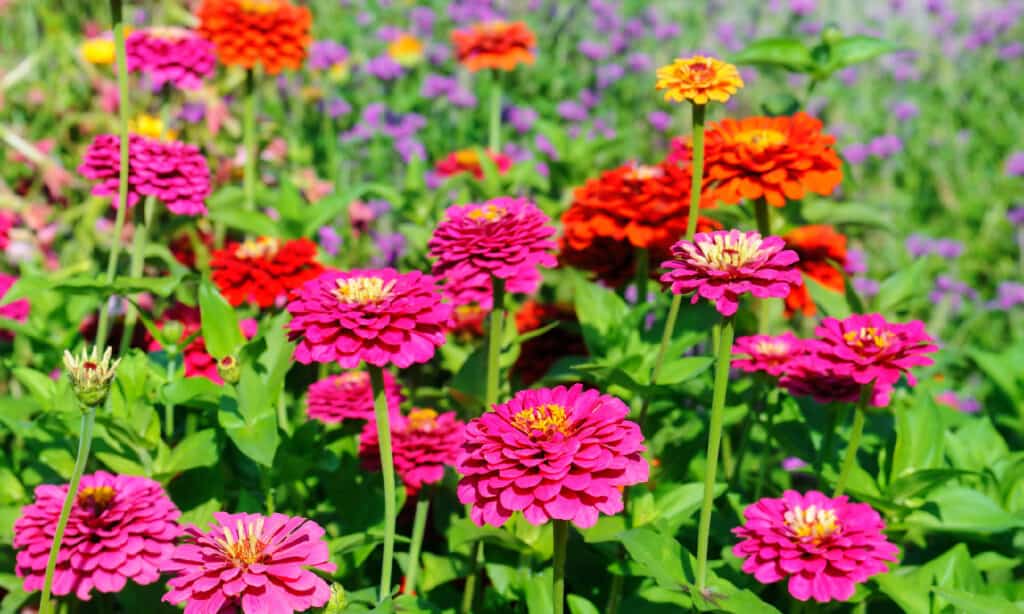
Attention! Tall and bold zinnias will draw all eyes to your flower garden.
©iStock.com/AlinaMD
Alphabetically, zinnias are towards the end of the list. But in any roster of easy-to-grow annuals that give plenty of bang for the buck, they belong at the top. Tall and showy zinnias add conspicuous bright color to any garden bed, so prepare for the neighbors to slow down and enjoy the view whenever they pass by. Along with spectacular color choices, zinnias varieties offer single or multiple rows of flower petals, different heights, and a range of flower shapes. They make great cut flowers, but before you cut them, they’ll attract bees and butterflies to your garden because pollinators will love them as much as you do.
Zinnias can bought as starter plants, or grown from seed in your garden bed after the last frost of the season has passed. Or you can grow seedlings indoors to get an early start. They like full sun (6-8 hrs daily) for best blooming, and enough water to keep the soil moderately moist. Cut off dead flower heads to encourage new blooms. But if you leave some flowers in place to set seed when autumn comes, you can harvest the seeds and plant them next year.
Impatiens: Right for any Light
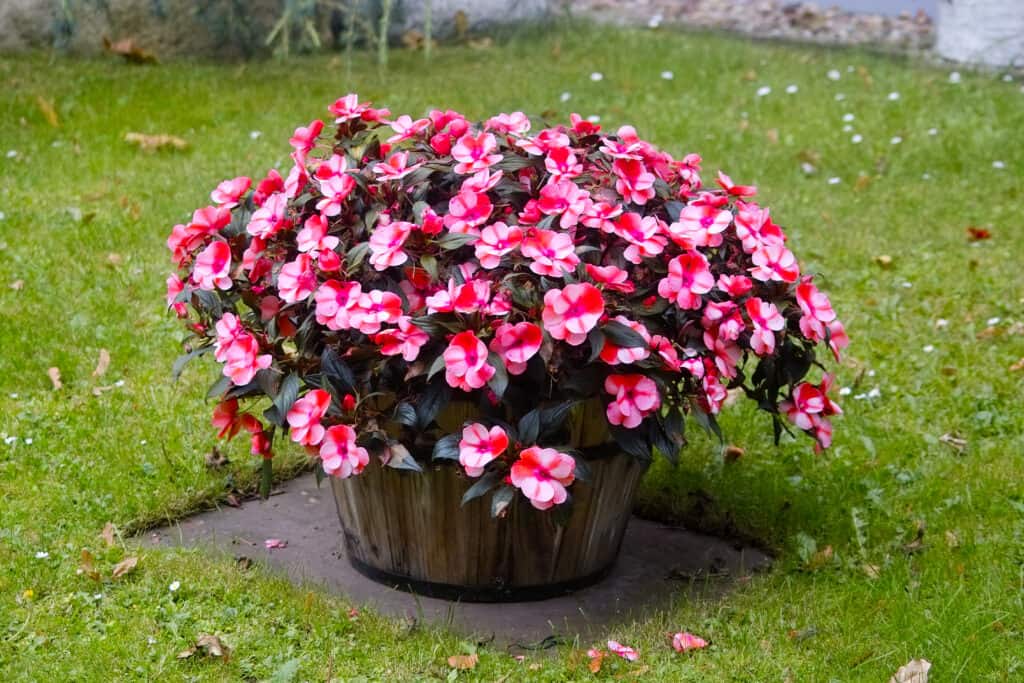
Thanks to new hybrids, impatiens can thrive in almost any garden.
©Ole Schoener/Shutterstock.com
OG gardeners knew this floral favorite as a shade-loving plant with small but mighty flowers that are perfect for adding pops of color to the shadowy side of the yard. Then came new hybrids with new possibilities: New Guinea impatiens, which can tolerate part sun, and hybrids like Sunpatients which are bred for full sun to part shade. So now there’s a variety for every placement. But when you buy your plants, you’ll want to check the tag to make you’re getting the type that matches your garden plan.
Impatiens are particularly frost-sensitive, so make sure that danger’s past before you plant. Expect Impatients to wilt if not given enough water; in garden beds, you can let the top of the soil get dry. But in pots or baskets, keep a close watch that the soil doesn’t dry out, especially in the heat of summer. Impatiens flowers drop off as they age, so no deadheading is necessary. But shade-loving varieties benefit from being pruned when they get tall (six inches or so). Try taking two inches off the top to encourage more branching and flowering.
Wax Begonias: Happy Inside or Out

Wax begonias are easy annual flowers to plant in your garden.
©Halit Omer/Shutterstock.com
Begonias are a huge plant group, with nearly 2,000 species worldwide. In fact, they’re the fifth-largest group among all flowering plants. When it comes to flower beds, you’re most likely to find the fibrous-rooted type, which includes the popular wax begonias. They’re versatile plants, able to adapt to different light levels. They tolerate heat and don’t need pruning or deadheading to keep producing their cheery single or double pink, red, or white flowers. And if you’re sad to see them die off at the end of the season, you can try potting them and bringing them indoors until next spring. Keep them in a sunny window, but out of reach of pets, as the plant can be mildly toxic to dogs and cats.
Once the danger of frost is over, and the outdoor temperature at night is over 50 degrees, you can plant wax begonias in a garden bed or place them in a windowbox or outdoor container. Part shade makes the best location, but they can do well in full sun, too. Let the top of the soil dry out between watering; this plant is more harmed by overwatering than underwatering.
Marigolds: Guardians of the Garden
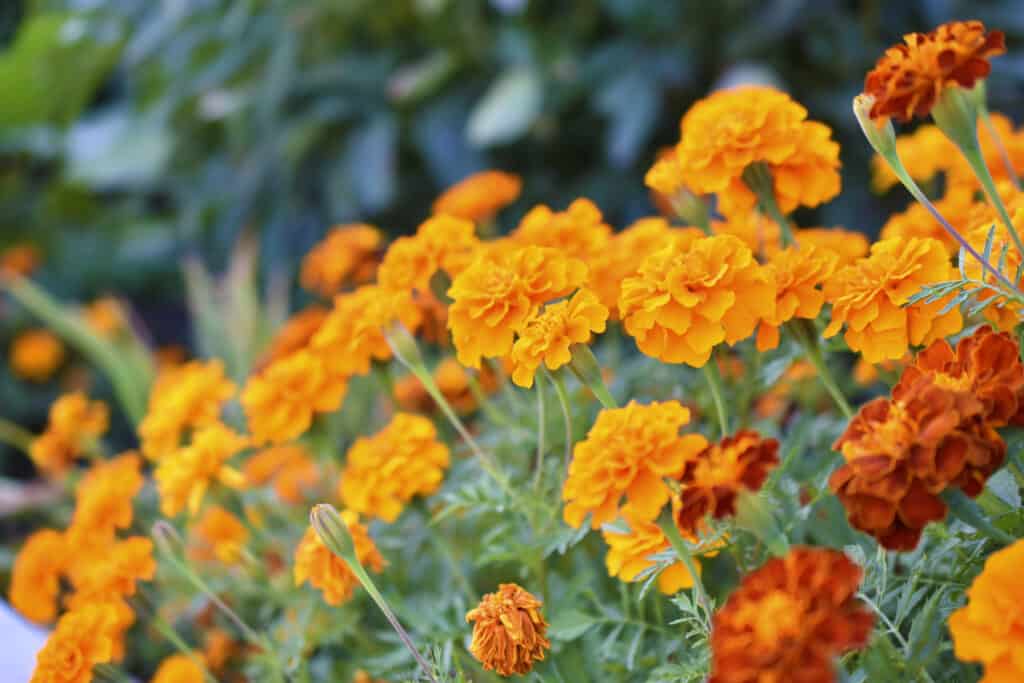
Plant marigolds near your vegetables to protect them from pests.
©iStock.com/Valeriy Lushchikov
The marigold isn’t just a flower bed favorite. It’s also a good friend to vegetable gardeners. That’s because these beautiful plants attract beneficial insects like ladybugs that prey on garden pests. Marigolds are also unpalatable to deer and rabbits, perhaps deterring the mooching munchers from sticking around for a snack. Their rich hues of orange and gold are displayed in different flower shapes, depending on the variety, from poofy pom-poms to ruffled petals to simple heart-shaped petals.
Marigold varieties can grow up to four feet tall, so check the stats when you buy to make sure you place them properly. Full sun is the best way to get an abundance of blooms. Plant in well-drained soil, and watch that garden beds or containers don’t stay dry for more than a day or two. Prune the plant early on and it will grow bushier, showing off more blooms as the summer goes on. Pick off spent flowers and your marigolds will keep blooming into the fall, just in time for Día De Los Muertos, the Mexican holiday that places marigolds front and center.
Sunflowers: Big and Beautiful
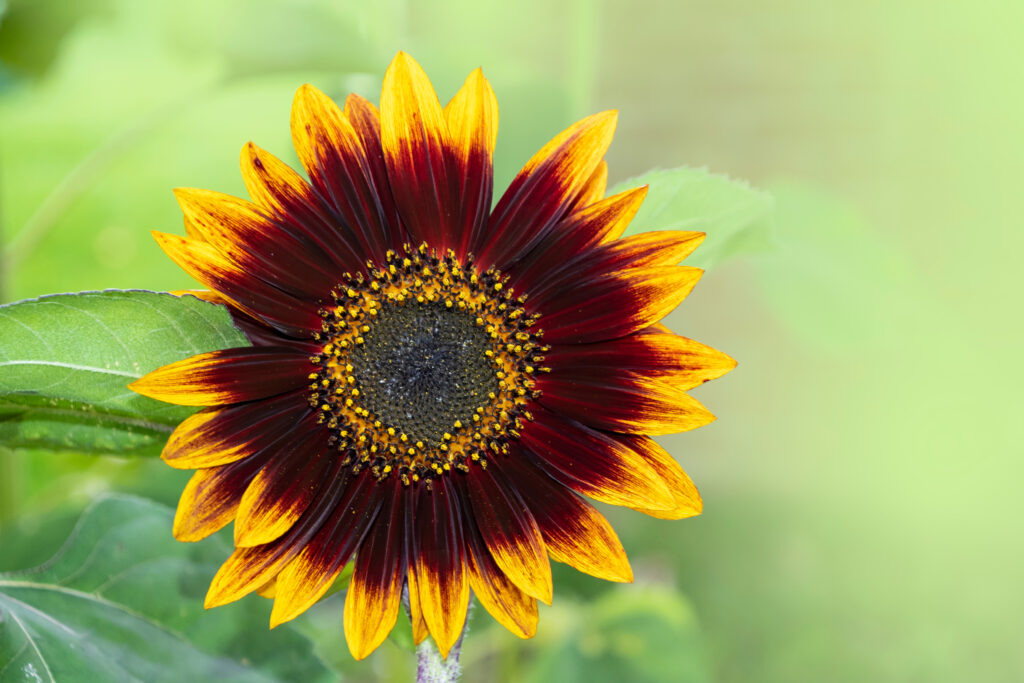
Among the biggest annual flowers, sunflower varieties come in oranges and reds as well as the traditional sunny yellow.
©Brita Seifert/Shutterstock.com
Few garden flowers make as bold a statement as a tall sunflower with its broad, large-petaled, sun-bright flowers. The tallest varieties can top surpass ten feet in height, but you can find shorter sunflower varieties for smaller spaces, and branching varieties that form bushy plants with multiple blooms. Sunflowers attract birds, bees, and other pollinators to your garden, and for all their showiness they’re not hard to care for.
You can start sunflowers from seed directly in your garden, though it might be a few weeks past the frost date before the soil’s warm enough for seeds to germinate. Or you can start the seeds indoors and transplant the seedlings. You can also get starter plants at the garden center to plant after the frost. Sunflowers like well-drained soil. And as their name implies, they like full sun, 6-8 hours a day at least. If you’re growing a very tall variety, keep in mind that the plant will be vulnerable to high winds, and will benefit from having some shelter to keep it from being knocked over in a storm. Don’t overwater your sunflowers; they usually can go a day or two between watering and don’t like staying wet.
Nasturtiums: Tougher Than They Look
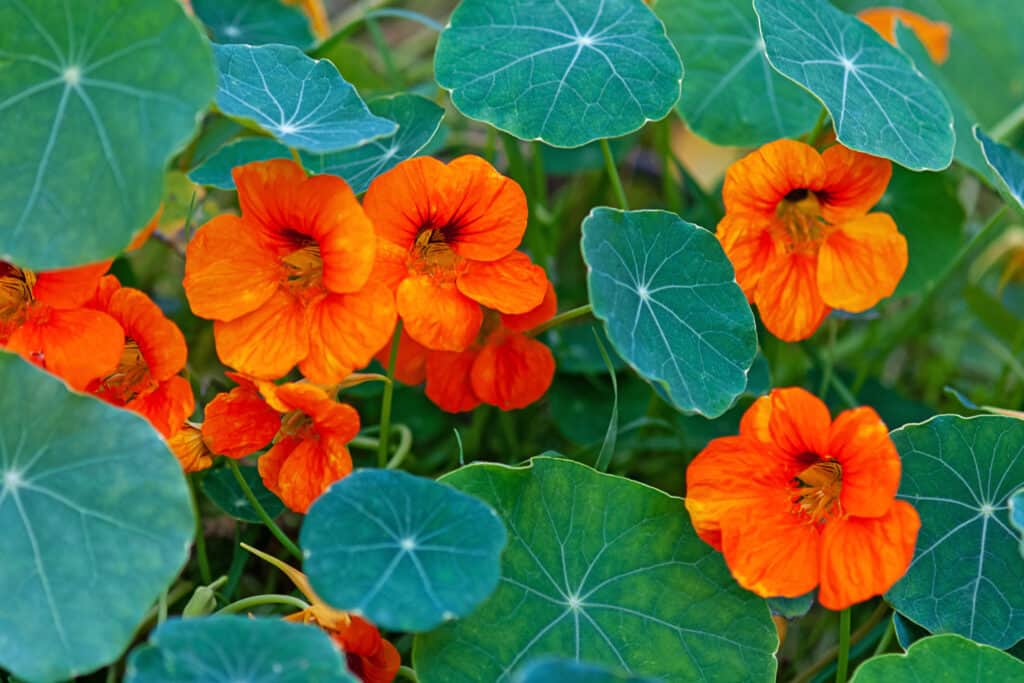
Small but mighty: nasturtiums are resilient annual flowers to plant in your garden.
©iStock.com/Nadya So
With their boldly colored but petite blooms, set against deep-green rounded leaves, nasturtiums may seem like the proverbial delicate flowers. They look suitable for growing around a quaint English cottage full of doilies and teacups. But don’t underestimate this plant! Nasturtiums are tough enough to thrive in poor soil—they prefer it, in fact—or even on stony ground, as long as it’s well-drained. If you forget to water them now and then, they’ll probably bounce back. And they grow quickly; trailing varieties will spill nicely out of window boxes and baskets, while the bush varieties are great for filling up empty spots in your flowerbeds. As a bonus, the leaves and flowers are edible! Pick them off and toss them in a summer salad for a peppery, mustard-like flavor.
Nasturtiums like full sun, but can grow in part shade (though you may get fewer blooms), whether they’re in the ground or in a container. Don’t overwater; let the soil dry out a little between waterings (you can wait for them to wilt a bit if you’re not sure how much is enough).
Cornflowers: Bring on the Blue

“Cornflower blue” isn’t just a color found on paint swatches.
©EQRoy/Shutterstock.com
Also called “bachelor buttons,” this is a can’t-fail carnation-like annual that can grow up to two feet tall. Its traditional blue color looks especially great in gardens of gold and yellow blooms, but new varieties offer white and pink options as well. Cornflowers are great cutting flowers, but you’d do well to keep some blooms in the garden: they attract pollinators that will help your vegetables grow, and who doesn’t like seeing butterflies flitting around their garden beds? Pick spent flower heads off the plant to encourage new growth; blooming may peter out after 10 weeks or so, but cornflowers grow easily from seed, so you can plant more batches after the first to keep the blue wave going longer into the summer.
Cornflowers like full sun, but will do fine in part shade. Be careful with watering; allow the soil to dry slightly but don’t let the plant dry out. In containers, make sure the potting mix drains well between waterings. Let some blooms go to seed and you’ll have plenty to plant next spring; you can start them indoors, or sow them right into your garden after the frost date has passed.
Cosmos: See You Again Next Year?

Plant wispy cosmos in your garden this spring, you might find these annuals return for an encore next May.
©iStock.com/Passakorn_14
With their tall, slim stems topped by daily-like flowers, cosmos are the picture of elegance. They add a stately presence to your flower garden, but also a bit of a wildflower vibe. Best of all, they’re not fussy about light, water, or care. In fact, some say these annuals thrive on neglect. You can pick up a pack of young plants at the garden center, but they’re easy to grow from seed, too. Cosmos take seven weeks to go from seed to bloom, though, so you might want to start them indoors and transplant them after the frost date.
Cosmos like to have at least a half-day of full sun and well-drained soil. They’re drought-tolerant plants, and once they’re established it’s better to err on the side of underwatering than overwatering them. Pick off faded flowers to encourage more blooming; if you cut flowers when they first open, they’ll last a long time in a vase with water. But try letting some of the flower heads stay on through the end of the season. Though they’re annuals, cosmos will drop seeds that could bloom into new flowers next spring, with no new planting needed.
Snapdragons: Give ’em a Running Start
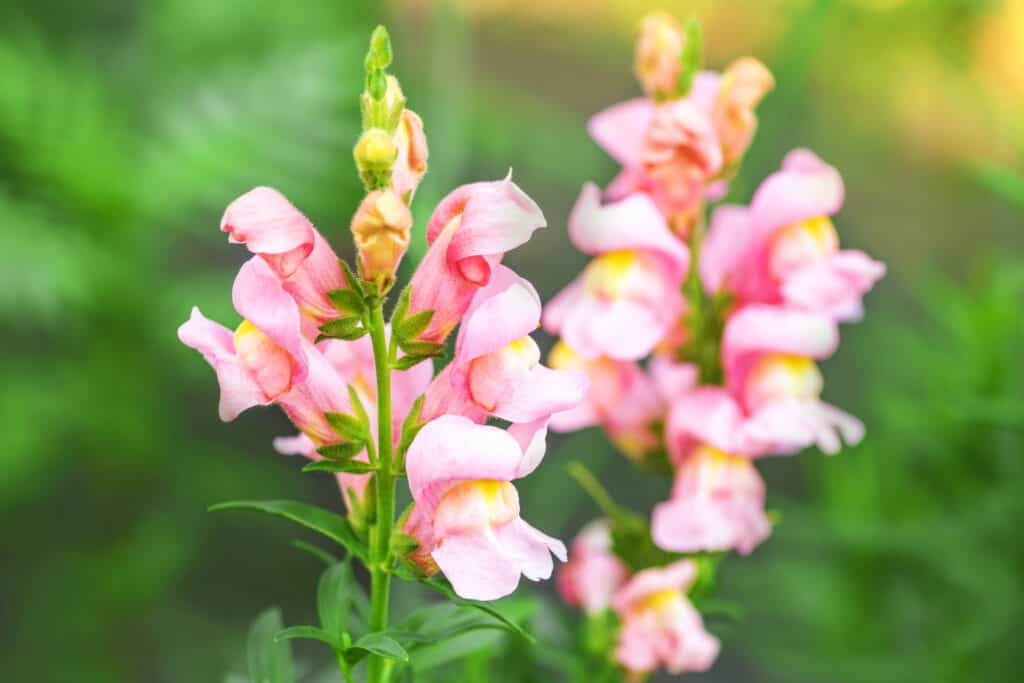
Snapdragons bloom best when the temperature’s under 80 degrees.
©iStock.com/Borislav
If you like an assortment of shapes and hues in your garden, you’ll love having snapdragons in the mix. Taller varieties are great for adding vertical color to a space. And this annual’s snout-shaped blooms—said to look like a dragon’s mouth opening when you squeeze them—add nice visual variation to your flower beds. Snapdragons bloom best in the cooler part of the summer. So if your summer temps reach above 80 degrees or so, it’s worth starting your snapdragons from seed 8-10 weeks before the frost date, so when you plant them outside they’ll be ready to crank out lots of flowers before the high heat hits.
Snapdragons are full-sun flowers. Keep the soil moist early on, and once they’re established and thriving, you can cut back on the watering. Deadhead old blooms to encourage new growth; you can cut off whole stalks once the blooms are spent. Keep caring for the plants and you might see a second wave of blooms once the hottest part of the summer has passed.
Thank you for reading! Have some feedback for us? Contact the AZ Animals editorial team.

